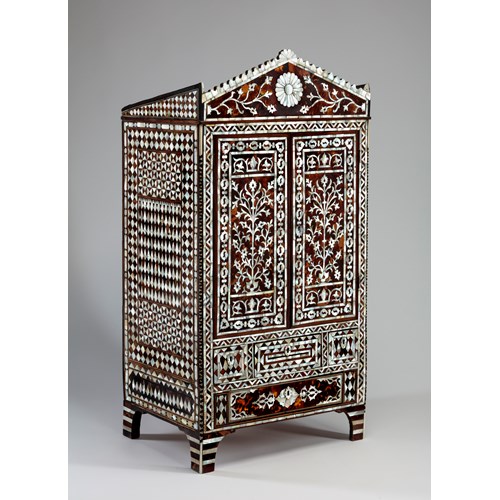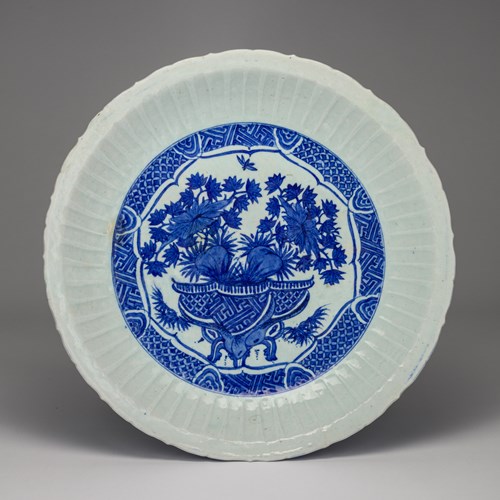Marketplace
Safavid Blue-and-White Charger
This large charger with a flat foot ring and notched rim is an outstanding example of 17th century Safavid blue-and-white ceramics. Modelled on Chinese Kraak dishes, Persian potters mimicked the translucent, bright white appearance of Chinese porcelain by applying oxide glazes over faience, a mixture of ground glass (frit), quartz, and clay. Kraak was a subcategory of Jingdezhen porcelain produced during the late Ming dynasty for the European export market. Though its etymology is disputed, the word ‘Kraak’ may derive from the Dutch word for ‘carrack’, the type of Portuguese cargo ship from which hundreds of examples of the Chinese porcelain were looted by the Dutch East India Company in 1630. En route to Europe, ships carrying Chinese porcelain sold some of their cargo in Persian and Middle Eastern ports, exposing Persian potters to Kraak ceramics.1 Greater interest was stimulated in blue-and-white ceramics following a visit by Shah ‘Abbas I to the Safavid ancestral shrine at Ardabil in 1604, where he left gifts including antique Chinese porcelain. The recapture of the Persian Gulf in the same year allowed the city of Kirman to grow and its ceramics industry to flourish. Safavid imitations of Ming porcelain were so accurate that they could pass for originals both in Persia and Europe.2
The wide rim and cavetto are decorated with eight lobed petal panels, each depicting different plants borrowed from contemporaneous Wanli porcelain. Depicted are plantain leaves, an unusual bulbous fruit, a flower, and a floral plaque. The ribbon dividers cover both flange and well. They are filled with geometric patterns, alternating between fish scales and an interlocking diaper design, which derives from a simplified version of the Chinese character 壽 (shòu), meaning ‘longevity’.3
Seventeenth-century Persian potters transplanted human figures from Chinese ceramics and relocated them to more local settings. Under the shade of a leafy peach tree, a popular motif in both Chinese and Persian culture, a bearded scholar reads a book under a canopy. The remaining three figures appear to be Portuguese, recognisable by their European dress composed of wide-brimmed hats and breeches. The Portuguese army conquered the Persian port island of Hormuz in 1507, thus starting over 100 years of conflict between the two nations. Contemporaneous Persian manuscripts illustrating clashes between Safavid and Portuguese troops, such as the Capture of Hormuz held in the British Library (MS Add. 7801, f. 44v), depict Portuguese soldiers with similar hats and trousers.4 At the time of this charger’s manufacture, Safavid-Portuguese conflict was reaching its climax. In 1602, the Persian army expelled the Portuguese from Bahrain. A decade later, the Portuguese Empire took the city of Gombroon and renamed it Comorão. Two years later, ‘Abbās the Great recaptured the city, naming it Bandar-e ‘Abbās. In 1622, with the help of the English navy, ‘Abbās retook Hormuz from the Portuguese.5 The central medallion therefore documents Iranian and Portuguese interaction, perhaps even illustrating a specific diplomatic meeting.
This charger is an excellent imitation of Ming porcelain. It is only distinguishable from Chinese porcelain by subtle details, notably its maker’s mark and black outlines. On the reverse of the charger is a square seal mark designed to imitate a Chinese framed reign-mark, or nien-hao. It has been thought until recently that pottery with square seal-marks originates from the city of Mashhad, whereas tassel-marks were used in Kirman. However, both Kirman and Mashhad used square seal-marks in the first half of the 17th century, with the square seal-mark only abandoned in Kirman in 1660. The formal square seal-mark seen on this charger, with symmetrical marks on each edge, is most consistent with seals used between 1573 and 1620 in Kirman.6 The details are outlined in black, and the appearance of shade is given with black dots, to imitate the rich blue outlines found in Jingdezhen porcelain. It is possible that the black outline comes from the Persian tradition of drawing in black ink. Towards the middle of the 17th century, black outlines disappeared in favour of cobalt pigment in most Kirman workshops, indicating that this piece was likely completed before 1650.
A dish dated between 1600 and 1640 with an identical square seal-mark is found in the collection of the Victoria & Albert Museum (accession no. 244-1884).7 Both dishes are ornamented with plantain leaves and the same unusual bulbous fruit. This may indicate the same artist or shared source material. The dividers on the reverse of both dishes are ornamented with identical comma motifs. Another dish belonging to the same group of blue-and-white ware in the Victoria & Albert Museum (accession no. 243-1884) has a similar square seal-mark. It too is ornamented with the unusual fruit, flowers, and plaque in its petal panels. A leafy peach tree decorates its central medallion, and the reverse features almost identical comma and cloud motifs.8
1 Macioszek, Amelia. ‘Negotiating Appropriation – Later Safavid Adaptations of Chinese Blue-and-white Porcelain’, Art of the Orient 8 (2019), pp. 75-92. P. 76.
2 Crowe, Yolanda. Persia and China: Safavid Blue and White Ceramics in the Victoria and Albert Museum, 1501-1738. London: Thames & Hudson, 2002. P. 21.
3 Macioszek, Amelia. Op. cit. p. 83.
4 Sardar, Marika. ‘Two Paintings Reflecting the Portuguese Presence in Iran and India’, in Peck, Amelia (ed.) Interwoven Globe: The Worldwide Textile Trade, 1500-1800. New York: Metropolitan Museum of Art, 2013.
5 Teles e Cunha, João. ‘Portugal I. Relations with Persia in the Early Modern Age (1500-1750), Encyclopaedia Iranica, 2009. Retrieved online https://iranicaonline.org/articles/portugal-i 22/10/23.
6 Golombek, Lisa, Mason, Robert B., and Proctor, Patty. ‘Safavid Potters’ Marks and the Question of Provenance’, Iran 39 (2001). pp. 207-236.
7 Reverse of V&A 244-1884 pictured in Golombek et al. op. cit. 211, fig. 1, and in Crowe, Yolanda. op. cit. p. 66, fig. 32.
8 See Crowe. op. cit. p. 62, fig. 24 for reverse.
The wide rim and cavetto are decorated with eight lobed petal panels, each depicting different plants borrowed from contemporaneous Wanli porcelain. Depicted are plantain leaves, an unusual bulbous fruit, a flower, and a floral plaque. The ribbon dividers cover both flange and well. They are filled with geometric patterns, alternating between fish scales and an interlocking diaper design, which derives from a simplified version of the Chinese character 壽 (shòu), meaning ‘longevity’.3
Seventeenth-century Persian potters transplanted human figures from Chinese ceramics and relocated them to more local settings. Under the shade of a leafy peach tree, a popular motif in both Chinese and Persian culture, a bearded scholar reads a book under a canopy. The remaining three figures appear to be Portuguese, recognisable by their European dress composed of wide-brimmed hats and breeches. The Portuguese army conquered the Persian port island of Hormuz in 1507, thus starting over 100 years of conflict between the two nations. Contemporaneous Persian manuscripts illustrating clashes between Safavid and Portuguese troops, such as the Capture of Hormuz held in the British Library (MS Add. 7801, f. 44v), depict Portuguese soldiers with similar hats and trousers.4 At the time of this charger’s manufacture, Safavid-Portuguese conflict was reaching its climax. In 1602, the Persian army expelled the Portuguese from Bahrain. A decade later, the Portuguese Empire took the city of Gombroon and renamed it Comorão. Two years later, ‘Abbās the Great recaptured the city, naming it Bandar-e ‘Abbās. In 1622, with the help of the English navy, ‘Abbās retook Hormuz from the Portuguese.5 The central medallion therefore documents Iranian and Portuguese interaction, perhaps even illustrating a specific diplomatic meeting.
This charger is an excellent imitation of Ming porcelain. It is only distinguishable from Chinese porcelain by subtle details, notably its maker’s mark and black outlines. On the reverse of the charger is a square seal mark designed to imitate a Chinese framed reign-mark, or nien-hao. It has been thought until recently that pottery with square seal-marks originates from the city of Mashhad, whereas tassel-marks were used in Kirman. However, both Kirman and Mashhad used square seal-marks in the first half of the 17th century, with the square seal-mark only abandoned in Kirman in 1660. The formal square seal-mark seen on this charger, with symmetrical marks on each edge, is most consistent with seals used between 1573 and 1620 in Kirman.6 The details are outlined in black, and the appearance of shade is given with black dots, to imitate the rich blue outlines found in Jingdezhen porcelain. It is possible that the black outline comes from the Persian tradition of drawing in black ink. Towards the middle of the 17th century, black outlines disappeared in favour of cobalt pigment in most Kirman workshops, indicating that this piece was likely completed before 1650.
A dish dated between 1600 and 1640 with an identical square seal-mark is found in the collection of the Victoria & Albert Museum (accession no. 244-1884).7 Both dishes are ornamented with plantain leaves and the same unusual bulbous fruit. This may indicate the same artist or shared source material. The dividers on the reverse of both dishes are ornamented with identical comma motifs. Another dish belonging to the same group of blue-and-white ware in the Victoria & Albert Museum (accession no. 243-1884) has a similar square seal-mark. It too is ornamented with the unusual fruit, flowers, and plaque in its petal panels. A leafy peach tree decorates its central medallion, and the reverse features almost identical comma and cloud motifs.8
1 Macioszek, Amelia. ‘Negotiating Appropriation – Later Safavid Adaptations of Chinese Blue-and-white Porcelain’, Art of the Orient 8 (2019), pp. 75-92. P. 76.
2 Crowe, Yolanda. Persia and China: Safavid Blue and White Ceramics in the Victoria and Albert Museum, 1501-1738. London: Thames & Hudson, 2002. P. 21.
3 Macioszek, Amelia. Op. cit. p. 83.
4 Sardar, Marika. ‘Two Paintings Reflecting the Portuguese Presence in Iran and India’, in Peck, Amelia (ed.) Interwoven Globe: The Worldwide Textile Trade, 1500-1800. New York: Metropolitan Museum of Art, 2013.
5 Teles e Cunha, João. ‘Portugal I. Relations with Persia in the Early Modern Age (1500-1750), Encyclopaedia Iranica, 2009. Retrieved online https://iranicaonline.org/articles/portugal-i 22/10/23.
6 Golombek, Lisa, Mason, Robert B., and Proctor, Patty. ‘Safavid Potters’ Marks and the Question of Provenance’, Iran 39 (2001). pp. 207-236.
7 Reverse of V&A 244-1884 pictured in Golombek et al. op. cit. 211, fig. 1, and in Crowe, Yolanda. op. cit. p. 66, fig. 32.
8 See Crowe. op. cit. p. 62, fig. 24 for reverse.
More artworks from the Gallery








